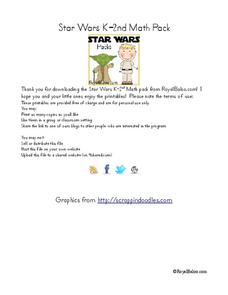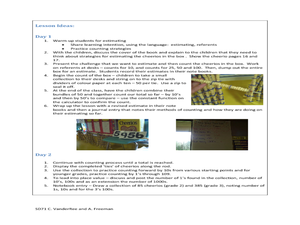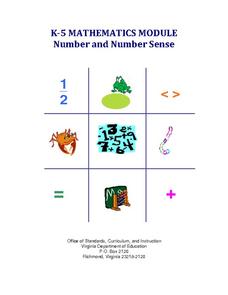Illustrative Mathematics
Counting Circles II
Fill those extra ten minutes of math time with this fun counting activity. Given a short sequence of numbers, young mathematicians stand in a circle and count one-by-one until the last number is reached, at which point the whole group...
Illustrative Mathematics
Start/Stop Counting II
Take stroll around the classroom while teaching young mathematicians to count fluently with this whole-group math activity. The teacher starts things off by walking around the room while counting up from the number one and continues...
Alabama Learning Exchange
Wheels All Around
Budding mathematicians explore the concept of skip counting. They practice skip counting as they use it to determine the number of wheels that come to school at 3 different times throughout the day. They also create a data graph to show...
Curated OER
Finding Patterns
What's the pattern? Learners skip count to complete 12 sequences, some of which increase and some of which decrease. As they solve each number pattern they count by 2, 3, 4, 5, 6, 10, and 100, getting some extra subtraction and addition...
Curated OER
Ordering
Four sequences are missing some numbers; can your scholars fill them in? These aviation-themed number sequences require skip counting and counting backward. Beside each pattern learners can reference a jumbled set of numbers inside a...
Curated OER
Frogs Hopping by 2s
Hop to it! Beginning counters fill in water lily number sequences as a frog "hops" across them, skip counting by twos. There are five sequences in total, and some require counting backward. Learners can reference the two examples, which...
Curated OER
Count by 5s, 10s, and 100s
These number sequences are missing digits! Each of the six has one missing number and scholars must figure out what it is. Here's the pattern, though: all of these sequences involve counting by 5s, 10s, and 100s. Learners add one of...
Curated OER
Relate Counting to Addition and Subtraction
Your math scholars may recognize patterns, but do they know they can use them to practice addition and subtraction? This worksheet has scholars counting by threes, fours, and sixes to analyze number patterns and complete a sequence....
Curated OER
Mentally Add and Subtract 10 or 100
Don't let the title of this one fool you; scholars skip count only by 10 in this number sequence instructional activity. They fill in missing numbers on a number line to complete each sequence, adding or subtracting 10. There are two...
Curated OER
Mentally Add and Subtract 10 or 100
Here are some number lines that need to be completed. There are two number sequences, one to test addition skills and the other for subtraction. Both sequences include counting by 10, but the subtracting question has scholars count...
Curated OER
Skip Counting by Two's
First graders practice their counting skills. In this skip counting instructional activity, 1st graders review counting by 1's with a song, use number lines to learn to skip count by 2, practice counting forwards and backwards, complete...
Curated OER
Counting by Two's-Skip Counting Lesson Plan
First graders practice skip counting. In this skip counting lesson plan, 1st graders practice skip counting on a number line. Then students sing a song to help them understand counting by two's.
Curated OER
Number Sequencing Packet
This dynamic 4-page packets challenges students to practice number sequencing. The sequences get progressively more difficult. Your class must count by ones, backwards, by twos, and by threes. Students can complete this packet as an...
Curated OER
Counting on Counting
Young scholars recognize that counting tells how many objects are in the set irrespective of how they are arranged or the order in which they are counted. They solve problems involving one more or less to a given set using their...
Royal Baloo
Star Wars K-2nd Math Pack
Included in a Star Wars themed packet, young padawans enhance mathematical skills such as graphing, computing using basic operations, counting numbers and money, telling time, and measuring. Scholars play a game of sudoku, read number...
Curated OER
Book Title: Great Estimations
Explore estimation with your math class. They will estimate how many Cheerios are in a box. Then count and group 50 Cheerios on a twist tie and attach groups to represent hundreds. They then discuss and practice skip counting and revise...
Curated OER
K-5 Mathematics Module: Number and Number Sense
Reinforce number sense with a collection of math lessons for kindergarteners through fifth graders. Young mathematicians take part in hands-on activities, learning games, and complete skills-based worksheets to enhance proficiency in...
Curated OER
My Time!
Learners explore how to tell time by looking at their daily schedule. Everyone's days start out the same (with school), but what does each learner do after school? How do they spend their time?
Alabama Learning Exchange
Triple Addition Shuffle
Get those kids practicing basic math skills. They practice adding 3 numbers together by playing the game "Triple Addition Shuffle." Each pair of learners shuffles number cards together, places them face down, then flips them over to...
Curated OER
Five Second Dash
Learners estimate how far they can run, jump, or hop in five seconds, then check their prediction. In this estimation lesson, student predict how far they can run, hop, or jump in five seconds and then try it.




















